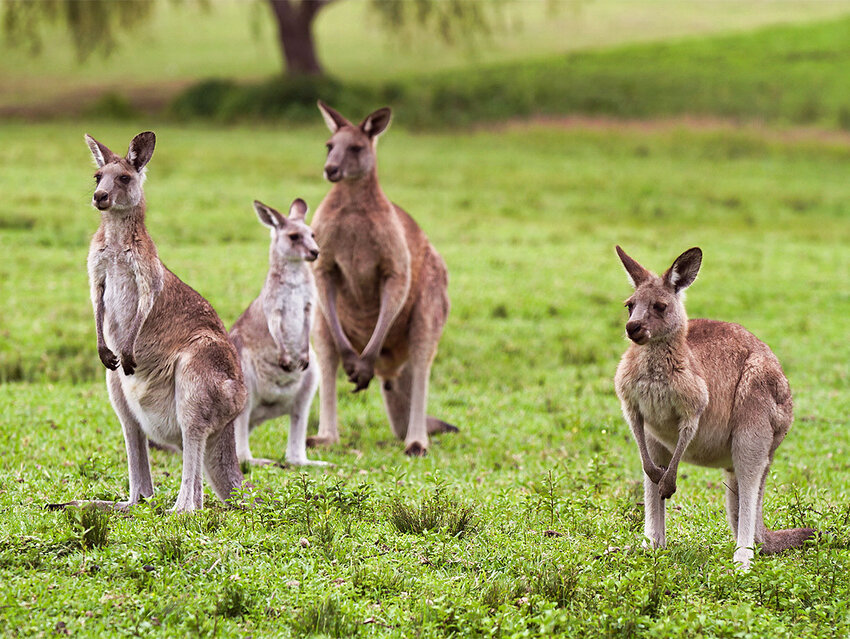For many word lovers, there’s great satisfaction in being able to toss out a “did you know?” for an obscure phrase or silly definition. One of the best ways to do this is with terms of venery, which is the formal title for names for groups of animals. “Venery” is an old-fashioned synonym for “hunting,” so these collective nouns usually have less to do with science and more to do with colorful descriptions. You’re likely already familiar with packs of dogs, prides of lions, and murders of crows, but let’s explore some of the lesser-known terms of venery.
Smack of Jellyfish
“Smack” is an onomatopoeia for a sharp slap or a blow, which is precisely how a jellyfish sting feels. This term of venery likely came from the idea of a painful encounter with a jellyfish. A group of jellyfish can also be called a “swarm,” and when a large swarm of jellyfish appears quickly, it is called a “bloom.”
Cete of Badgers
The beloved state animal of Wisconsin — the badger — is a social creature that lives in groups called “cetes.” The noun “cete” was first recorded in the 15th century, likely a variation of “cite,” the Middle English word for “town.” Each cete has its own network of underground burrows called a “set” (sometimes spelled “sette”).
Shiver of Sharks
A “shiver” of sharks is a small group with a close social bond, perhaps a family. Only certain shark species, such as whale sharks, exhibit this behavior. In a shiver, the sharks swim close together in synchronized movements. They often do this while resting, as the proximity provides safety. “Shiver” was likely adopted for alliteration, yet its definition, “to shake slightly and uncontrollably as a result of being frightened,” is something humans might do during a shark encounter.
Sloth of Bears
According to medieval hunters, bears were rumored to be very slow — so slow, in fact, that hunters called groups of bears “sloths” from the Middle English adjective for “slow” (“slauðe”). Of course, bears aren’t actually slow, but perhaps their long stretches of hibernation played into the reputation and the name. This Middle English word is also where the Central American slow-moving, tree-dwelling mammals got their moniker.
Paddle of Platypuses
According to the Australian Platypus Conservancy, the collective noun for platypuses is “paddle,” likely referencing their oar-shaped tails and wide flippers, which act as paddles. These duck-billed, semi-aquatic creatures are endemic to Australia. However, they are solitary creatures, so the term “paddle” rarely needs to be used; they aren’t often found in groups.
Mob of Kangaroos
The word “mob,” meaning “a large crowd of disorderly people,” has been around since the mid-17th century, and has been used for kangaroos for almost as long. It was used to describe kangaroos beginning in 1846 and is one of the definitions of “mob” in The Australian National Dictionary. The name might have arisen due to kangaroos’ rowdy behavior; male kangaroos often box to assert dominance. A group of kangaroos can also be called a “troop” or a “court.”
Fever of Stingrays
Stingrays are known to amass in the thousands, and in such large numbers that when they feed it looks like a frenzy of movement. The collective noun “fever” originated from the word’s lesser-used definition: “a state of nervous excitement or agitation.” The adverb “feverishly” aptly describes stingrays’ swift movements as “in a frenetically excited or energetic manner.”
Waddle of Penguins
There are several terms of venery for penguins, but the most endearing is “waddle,” which references penguins’ short, clumsy, swaying motion when walking. “Waddle” has existed since the 16th century and was derived from “wade.” While “waddle” describes a group of penguins walking on land, “raft” is the collective name for a group of penguins in the water. They spend a lot of time floating on the surface between hunts, creating a literal penguin raft. While the parents hunt, groups of chicks band together for safety. This type of group is called a “crèche,” from a British word for a nursery. Moreover, when a large group (hundreds or even thousands) of these birds gathers during the breeding season, it is called a “crook” or a “rookery.”
Prickle of Porcupines
A group of these large rodents is called a “prickle” because of their sharp spines, also called “prickles.” The term comes from the Old English word pricel, which was an “instrument for pricking” or “the sensation of being pricked.” The word “porcupine” is of a different origin, stemming from the Latin terms porcus (“pig”) and spina (“thorn”).
Streak of Tigers
This noun of venery describes a female tiger and her cubs. “Streak” is an apt name for tigers for two reasons: It defines a “long, thin line of a different color” (similar to a tiger’s stripes), and it also describes a “swift move in a specified direction,” which is how tigers move. Either of these definitions could be the origin of the association. Another term of venery for tigers is “ambush,” which describes a group of adult tigers (and their style of hunting).
Featured image credit: Gilmore Tana/ iStock

